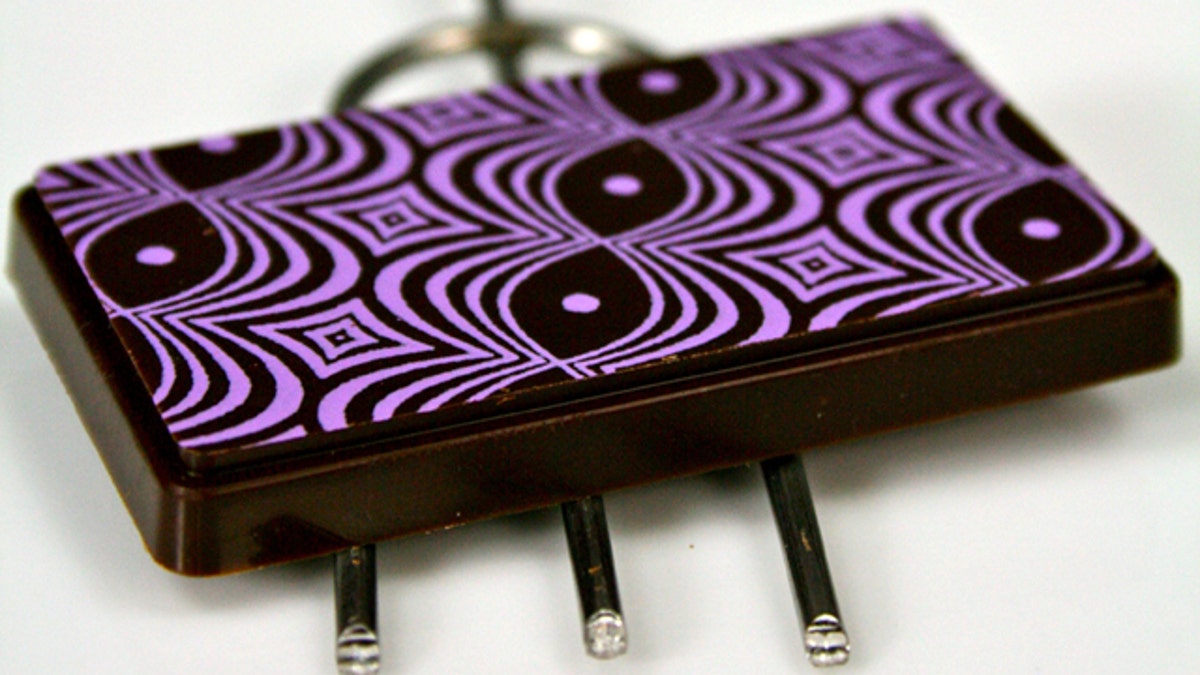
(The School of Pastry Design in Las Vegas)
“I filled a scuba tank with CO2,” says Chris Hanmer, owner of The School of Pastry Design in Las Vegas. “It set the chocolate faster but more importantly it was incredibly loud and you could see the other competitors stop and look up. Psychological warfare is fair game,” he says. Besides psy-ops and CO2, Hanmer’s arsenal includes tools for blowing molten sugar, blowtorches, liquid nitrogen and the best that Chef Rubber has to offer.
You’ve got to be tight with Chef Rubber to win. Hanmer is. They’re in the same building. So when a competition rolls around, Hanmer strolls over to Chef Rubber and helps himself to professional-grade pastry equipment like silicone molds, colorants and transfer sheets. Or he orders up a custom-designed mold. Having the right equipment is partly why Hanmer wins, and he wins a lot. He was the youngest-ever winning American chef for a World Pastry Team Championship when Team USA won in 2004. And he’s won two out of five "Food Network Food Challenges" - Extreme Candy Coasters (i.e. roller coasters) and Runaway Chocolate.
For Runaway he suspended a turn-of-the-century twenty-pound chocolate woman on a bicycle in a flowing chocolate dress on a two-inch wide chocolate track and rolled her. He says it’s the most difficult piece he’s ever done, not just because of the design, but because the final showpiece had to move.
Thing is, chocolate doesn’t like to move. It’s not completely rigid and subtly changes shape. “If I ladle chocolate onto a piece of paper the chocolate will naturally curl up,” he says. “It contracts as it cools,” and it doesn’t revert to its original form. “You pour perfectly round wheels,” says Hanmer, “but once you apply force, once they bear weight, they’re no longer perfectly round.” He was left to hope and pray that the wheels would roll and the piece would hold together.
He also wanted the woman’s dress to move like real fabric. But a dress made from chocolate or pastry staples like marzipan or gum paste, which harden and become brittle, would break when he pushed the bike. So he invented “flexible” chocolate by combining chocolate, gelatin and other ingredients he’ll “reveal in a book some day.”
He and his colleagues spent a year creating the World Championship winning entry. Food Network Challenge prep-time averages about sixty days, which includes being invited, cast, vetted and sent on an “inspiration trip.” “It doesn’t sound that bad but it’s like meeting someone and getting married in that time-frame,” he explains, all while holding down a full-time job, dealing with personal responsibilities and coming up with a winning design. And you have to keep in mind that it’s a made-for-TV event, which means your creation has to have a wow-factor.
Hanmer mounted a spherical showpiece on a custom metal structure (thank you, Chef Rubber) for the Sugar Destinations challenge and shot liquid nitrogen mixed with pure alcohol into melted sugar to make coral. “It made the sugar bubble instantly and looked exactly like real coral,” he says. “It was visually awesome.”
The best place in any professional kitchen is the pastry area because it’s always air-conditioned while the rest of the kitchen feels like a sauna. But pastry is labor-intensive and time-consuming and you have to love duplication - making the same thing, the exact same way, every single time. It’s like cloning by hand.
Hanmer started working in restaurant kitchens at fifteen and began competing while attending Orange Coast Community College. After a series of jobs and competitions he landed at The Bellagio in Las Vegas and then became executive pastry chef at the Ritz-Carlton across town. He decided to open his school after getting ninety-days notice that the Ritz-Carlton was closing. There he shares all of his trade secrets in eight-hour classes with a maximum of six students each.
“Some clients come to develop a new bon bon line, some are entrepreneurs starting a new business,” he says. A lot of people come because they’ve seen him on TV and want to make what they’ve seen. There are no assistants and no helpers, only him.
He teaches basic sugar techniques - pulling, blowing and casting. Sugar occupies a very narrow temperature range and working outside of which generates breakage and frustration. “Melting sugar involves evaporation, heat sources can be different and then there are environmental factors. Each batch differs slightly,” he says. You need a good warming box to maintain the right temperature and you need to work with it every day. If you’re pulling petals to make a rose you have to know how to assemble them so that they actually resemble a rose and not, say, a cabbage.
Chocolate is also temperamental. It can’t be melted it needs to be tempered. Tempering means heating, cooling and gently re-heating. This aligns the chocolate crystals and creates the right consistency. Melt chocolate and start dipping strawberries. By the tenth strawberry the chocolate will have hardened into a grayish, grainy, chalky lump. Tempered chocolate stays gooey. It dries shiny, crisp and smooth. The secret is controlling the temperature at each step. Once you’ve mastered that, Hanmer says you can mold, shape, texturize, paint, pour, airbrush it. “Anything but make it clear,” he jokes.
Hanmer describes his method as “creativity through brute force” meaning that despite setbacks he never gives up. His pieces are sculptural, modern, sleek. He has no artistic training only a tactile gift. “I’m living proof that you don’t have to sit in front of computer to feel that sense of accomplishment,” he says. “You can still earn a good living working with your hands.”
